10 Tips to Buying Diamond Engagement Rings on a Budget
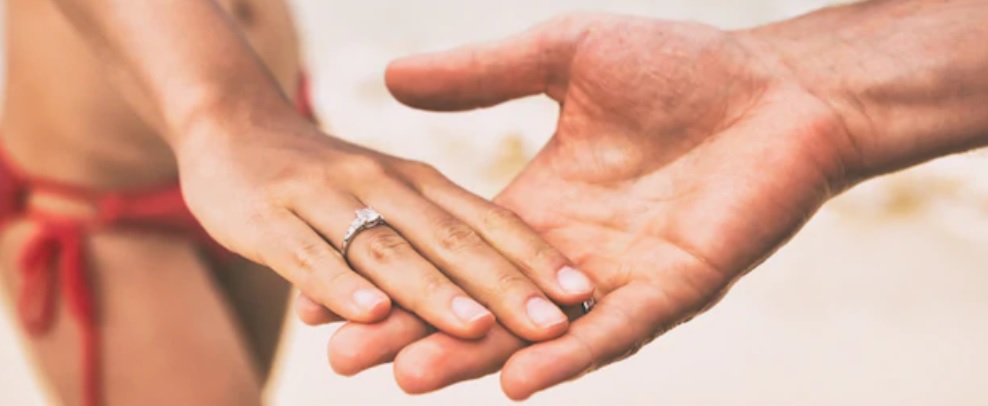
You have finally found that perfect person to spend your life with – congratulations! And you are now ready to commit to that individual and propose with an engagement ring. This is a huge step forward and it does take some advance planning.
In this write up, I’m going to reveal 10 useful tips to help you save money and show you how to buy a high quality diamond engagement ring on a budget. Let’s get started!
Here is a list of topics we will be covering:
- 1. Determine The Budget You Want to Spend And Stick With It
- 2. Learn And Understand The Basic 4Cs
- 3. Only Buy a Diamond Certified by a Reliable Lab Like GIA or AGS
- 4. You Don’t Need a High Color Grade to Get a White Looking Diamond
- 5. Buy Diamonds With Lower Clarity Grades That Are Eyeclean
- 6. Buy a Slightly Smaller Diamond Below Benchmark Carat Weights
- 7. Buy Online Instead of Locally
- 8. Consider Lab Grown Diamonds Instead of Mined Diamonds
- 9. Choose the Right Diamond Ring Setting Style
- 10. Choose 14k or 18k Gold Instead of Platinum
- Summary: Buying an Engagement Ring on a Budget
1. Determine The Budget You Want to Spend And Stick With It
Setting a budget before you go shopping is critical as it prevents you from overspending. Trust me. Once you start browsing around or walk into a jewelry store, it’s easy to throw your budget out of the window.
A well known “rule” in the industry is to spend the equivalent of 3 months of your salary on your diamond engagement ring. That’s actually something conveniently created by the diamond industry to make you spend more.
In my opinion, you should spend what you can comfortably afford without getting into debt for a diamond ring. And once you set your budget, stick with it!
2. Learn And Understand The Basic 4Cs
The 4Cs (cut, carat, color and clarity) are attributes that are used to define the quality of a diamond. Depending on the combination of the 4Cs, the price of a diamond can vary significantly.
Below is a quick summary of what each C represents. I recommend that you click on the corresponding links to find out about each of them in more detail.
Cut refers to how well crafted and proportioned the facets of a diamond are. It determines the sparkle and performance of the diamond.
Carat refers to the metric weight of the diamond and 1 carat equals to 200 milligrams. Most beginners misunderstand carat weight to be a physical representation of the diamond’s face up size.
Color is evaluated on the absence of color in the diamond. GIA’s D-Z color grading scale is the most widely used in the industry where D represents a completely colorless diamond and Z represents a lightly colored diamond.
Clarity is an assessment of the imperfections and inclusions found in a diamond. A scale from Internally Flawless (IF) to Included (I3) is typically used to grade diamonds.
3. Only Buy a Diamond Certified by a Reliable Lab Like GIA or AGS
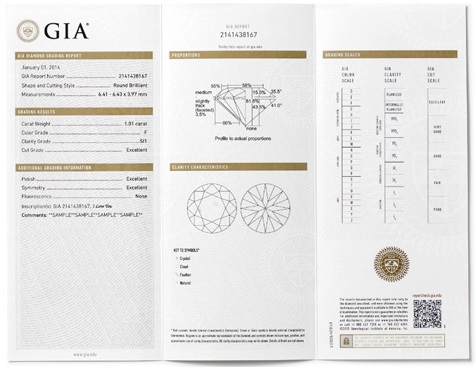
The GIA grading report is highly reliable and accurate.
When buying a diamond engagement ring on a budget, one common mistake that uneducated shoppers make is to buy an uncertified diamond or one that comes from a lab with a dubious reputation.
If you buy a diamond that isn’t graded by GIA or AGS, you can almost be sure that the diamond has inflated grades (a H color is in reality, a K color or a VS2 clarity is in fact, an SI2 grade).
This is a very common scam run by unethical vendors to give consumers an illusion of getting a great deal when they are actually buying a lower quality diamond at inflated prices.
4. You Don’t Need a High Color Grade to Get a White Looking Diamond
If you are looking for a budget engagement ring, you obviously can’t expect to pay low prices while expecting the best of the best in a diamond’s material qualities.
One money saving tip I have for readers is to look for diamonds in the near colorless range (G-J) as they can face up white and look indistinguishable besides a high color grade diamond.
For example, a D color diamond can cost 20-30% more than an H color diamond because of rarity factors. However, the visual differences between these diamonds are very subtle and almost undetectable to the untrained eye.
Check out this video below where I compared D vs H vs K color diamonds in different lighting environments. Are you able to tell the color differences apart easily or do you find it extremely difficult to do so?
5. Buy Diamonds With Lower Clarity Grades That Are Eyeclean
Similar to color gradings, the clarity of a diamond is often misunderstood by first time shoppers. Most people have a misconception that a diamond with higher clarity will have better sparkle and brilliance. That is a function of cut quality and not clarity.
The fact is, an eyeclean VS2 diamond will look identical to a VVS1 or IF diamond in a side by side comparison. However, the difference between a VS2 and flawless diamond is huge.
6. Buy a Slightly Smaller Diamond Below Benchmark Carat Weights
Diamond prices are largely determined by the 4Cs and carat weight is the factor that has the biggest impact. Prices jump exponentially at the psychological marks of 0.5ct, 1.0ct, 1.5ct and 2.0ct.
1 carat sized diamonds are very popular choices because of their nice rounded number and prices are higher because of their demand. If you are shopping for a diamond ring on a budget, you may want to buy just shy of the 1ct mark (i.e. near 0.9ct).
This can result in savings of up to 20% even though the visual size differences between the 2 diamonds will be hardly noticeable.
7. Buy Online Instead of Locally
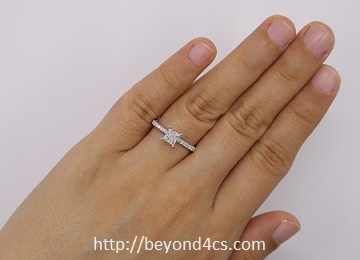
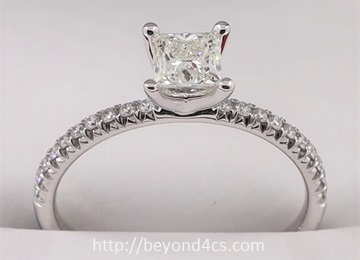
I bought this breathtaking princess cut ring for only $2,000!
Buying in a brick and mortar store severely limits the selection and quality of diamonds you have available to choose from. On top of that, the high overheads of running a physical store are passed down to you which results in higher prices.
Shopping at reliable diamond dealers like James Allen or Blue Nile can allow you to cherry pick the perfect diamond from their massive inventory and enjoy 20-50% lower prices. Not only that, you also get better transparency on your diamond purchase and enjoy 100% risk-free sales policies.
8. Consider Lab Grown Diamonds Instead of Mined Diamonds
Lab grown diamonds are chemically and physically identical to natural diamonds and had been gaining traction amongst consumers. In recent years, the technology to create lab grown diamonds has improved tremendously leading to better yield and cost efficiencies.
This had led to significantly lower prices compared to naturally mined diamonds. If your recipient doesn’t mind one that is grown in the lab instead of being dug from the ground, lab grown diamonds are ideal choices for budget engagement rings.
Here’s a price comparison between 2 E/VS2 0.9ct diamonds for you to get an idea of their price differences.
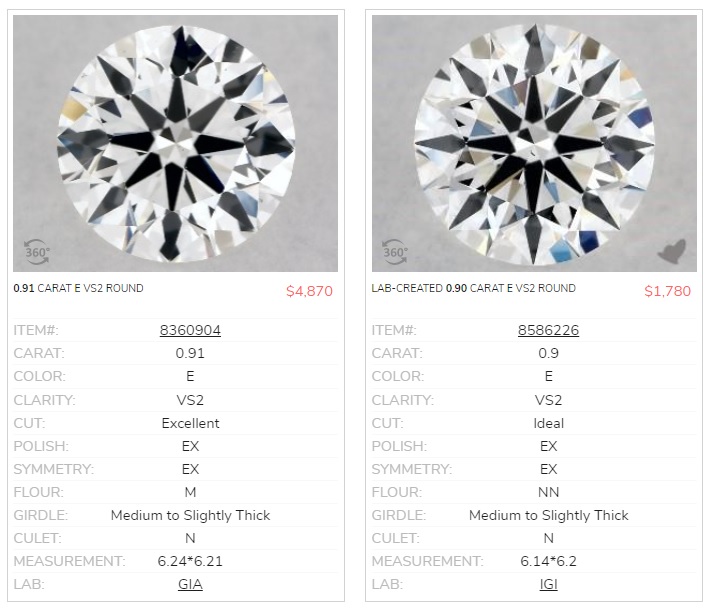
Feel free to do your own price comparisons at James Allen.
9. Choose the Right Diamond Ring Setting Style
As mentioned earlier, the biggest factor that affects the price of a diamond is carat weight. In my opinion, some of the best engagement ring ideas on a budget are halo or pave settings.
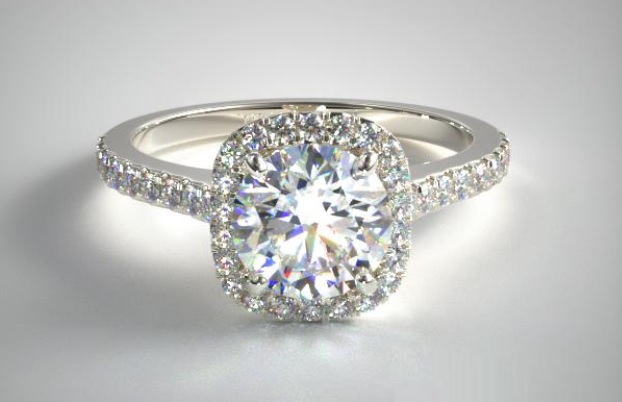
A cushion shaped halo encircles the center stone of this ring design.
Halo settings are basically ring designs that have melee diamonds outlining the shape of the center stone. This creates an illusion of a large looking diamond when seen from a distance and adds another dimension of sparkle to the ring.
Similarly, pave settings utilize tiny diamonds lined along the shank to help draw the attention of the eye towards the center stone. This can help boost the appearance of a smaller center stone and create a more flashy look to the ring.
10. Choose 14k or 18k Gold Instead of Platinum
The choice of precious metal you use for your engagement ring setting can lead to significant price differences. While platinum is the most popular metal used in engagement rings, it is also more expensive because of its rarity and denser weight.
White gold is a better alternative when it comes to costs and the same ring design can cost a lot less compared to the platinum version of the ring. For example, this 14k white gold solitaire ring costs $480 while the platinum version costs $900.
As you can see in the video above, it’s almost impossible to tell a white gold ring apart from a platinum ring. Unless you are allergic to nickel, you can save some money by choosing a white gold ring.
Summary: Buying an Engagement Ring on a Budget
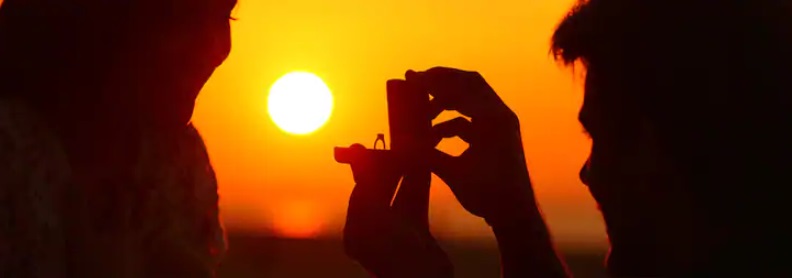
With that, we have come to the end of the article and I hope you found it useful! As a bonus for reading all the way through, there is one more tip I want to share with you: Plan a killer proposal. Yes, that’s right.
Pick a spot that is special to both of you and ensure that you have plenty of time to plan for the proposal. You also want to set aside at least 1 month’s time to shop for the ring and not rush through things at the last minute.
Above all, do remember that it is the commitment to stay together that matters more than anything else. If you can keep these 10 tips in mind, you are well on your way to buying that perfect ring for the marriage of your dreams.
Related Articles
Leave A Comment

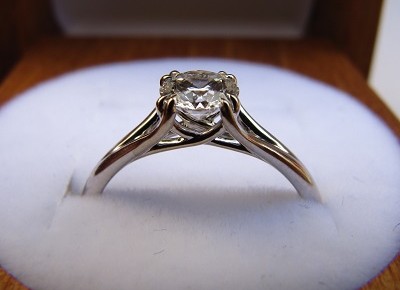

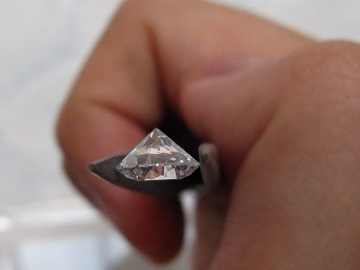
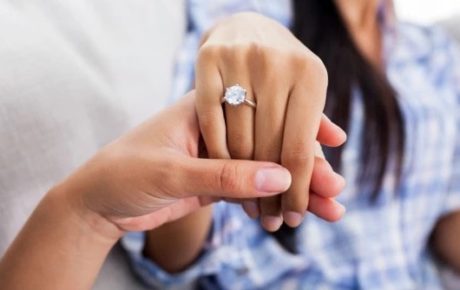









16 Comments
I noticed a black spot on the hearts at the 9 o’clock direction. Does this impact the hearts and arrows patterning? Are there any places in the UK that offer affordable engagement rings for college students?
Strictly speaking, severe inclusions that cover up the hearts or block up a significant part of the patterning will not affect the cut precision or patterning. Cut quality is cut quality and inclusions fall under clarity which doesn’t have any relationship with how well or badly the diamond was cut.
You could take a I2 or I3 garbage quality diamond and cut it to hearts and arrows standards but not many people would want to buy the stone because of the ugly inclusions.
I hope this makes sense.
For a more detailed read on the guidelines, go to: https://beyond4cs.com/hearts-and-arrows/guidelines-for-optical-symmetry/
To answer your second question, if you are looking for affordable engagement rings on a budget, heading online is the best way to stretch your dollar. The vendors in US ship regularly to the UK and I’ve had many readers who bought from the US vendors with zero issues. If you want to strictly work with a UK based vendor, you can consider Blue Nile: https://beyond4cs.com/go/bluenile/
This is a very nice and informative website. Keep up the good work.
I am a graduate student doing my PHD and am buying an engagement ring on a budget of $3000. My preferences are as follows:
1) round brilliant cut
2) must be sparkly and bright
3) biggest carat weight possible. I’ll be willing to compromise on color down to a J grade.
Can you help?
Sure! I dropped you a private email for further assistance on this.
Paul
Hello,
Great website you have here. It’s very informative and helped me gain a better understanding of how to buy an engagement ring on a budget.
I have a budget of around $1500 to $1600 for a proposal ring that I want to surprise my girlfriend for her upcoming birthday. Currently, both of us are students doing our final year of undergraduate studies at Ohio university. I’m a physics guy while she majors in biological sciences.
Though I have a small budget (took me a while and tons of part time jobs to save that up), I would still like to get the biggest and brightest stone possible. Following your advice that cut is of utmost importance when choosing a diamond, I narrowed my selection at James Allen down to the following diamonds.
–
jamesallen.com/diamonds/D-SI1-Ideal-Cut-Round-Diamond-1493108.asp–
jamesallen.com/diamonds/G-VVS2-Excellent-Cut-Round-Diamond-1464102.asp–
jamesallen.com/diamonds/G-VVS1-Excellent-Cut-Round-Diamond-1434315.aspThe diamonds listed above had been sold and no longer available. However, you can still click here to visit James Allen to browse through diamonds and interact with their intuitive 360˚ videos.
I liked the first diamond the most but am quite concerned about the black inclusion I can see with the loupe. For the other 2 diamonds, they seemed to be nicely cut as well with nice arrows and have AGS 0 cut grading.
This is the setting that I am looking at:
https://www.jamesallen.com/engagement-rings/solitaire/18k-white-gold-2mm-knife-edge-solitaire-engagement-ring-item-7027
I would like to hear your thoughts on these diamonds.
Did I miss anything out? Thanks for your help.
Charles
Thanks for writing in. First of all, I want to congratulate you on your decision to pop the question. No budget is too small to purchase a ring that symbolizes your love affirmations towards your partner. To me, a wedding engagement ring’s true value lies deeper than how many carats the diamond is.
I am glad you decided to contact me with your questions.
All 3 diamonds you had picked possess great cut quality. First of all, the D SI1 diamond you chose has an inclusion which could possibly be seen by the naked eye. However, the great thing is that this inclusion is “prongable”. When the diamond is set in the ring, it can be done in a manner in which the prong will cover up the inclusion. This in turn makes it eye clean.
For the other 2 G colored diamonds you had chosen, they do lie in the higher clarity grades and you are effectively going to pay for a feature that you or your future wife to be can’t appreciate with the naked eye.
With the engagement ring setting costing you around $400, it leaves us about $1200 to work around for the diamond. ($1300 if you decide to go for 14k white gold for your setting)
Here are 2 other great looking stones I would recommend you to consider:
–
jamesallen.com/diamonds/diamonds/J-SI1-Ideal-Cut-Round-Diamond-1493069.asp–
jamesallen.com/diamonds/diamonds/J-VS2-Ideal-Cut-Round-Diamond-1493058.aspThe diamonds listed above had been sold and no longer available. However, you can still click here to visit James Allen to browse through diamonds and interact with their intuitive 360˚ videos.
They are slightly bigger stones ( > 0.50 carats ) and both will face up white when set.
Hope this helps.
Paul
I’d had looked at the stones you had recommended. Aren’t J colored stones going to look slightly yellowish?
A well cut J colored stone will face up like a colorless stone. In fact for smaller diamonds, the color won’t show up easily. That’s one of the advantages for going small. When you combine this with an ideally cut stone, a J will look colorless even if you put 2 diamonds (say an G colored diamond) side by side for comparison.
A G color diamond vs a J color diamond in the chosen solitaire setting design.
However, you would be able to pick up a tinge of slight yellowness if you place a D colored diamond right beside the J colored diamond in a face up comparison. But think about it. How often would such a scenario occur in reality?
Would your fiancee be going around the campus and comparing her proposal ring with others?
For more examples of color comparisons, click here. In my opinion, maximizing your budget for cut and carat weight would provide you with more value than going for higher colors or clarity.
With all that said, it still boils down to personal preferences at the end of the day.
I see. Thanks for the insights. Between the 2 J colored diamonds, which would you chose and why?
I would pick the J SI1 as my first choice. If I’m being super anal, then I would say this is the option that is cut more precisely. If you look at the Idealscope and hearts patterning images, you’ll see a more symmetrical shape and better cut quality on this stone.
Optical patterning that shows perfect hearts and arrows
The truth is, when you view both of these diamonds with your eyes, you will hardly see any major differences between them in terms of brilliance and sparkle. Since the SI1 comes at a better price and has better optical symmetry, I think the choice is pretty straightforward here.
Either way, you won’t go wrong with either of the stones or the D colored SI1 diamond that you first picked.
I can’t thank you enough for your informative advice and helping me out with a budget engagement ring. By the way, how do you make money if you are offering your time and advice for free?
It’s been a pleasure.
Please read this: https://beyond4cs.com/about/ftc-disclosure/
We cover our website’s operations mainly through advertisements you see on our website as well as referral fees. For example, we would get a small commission from JamesAllen.com if someone decides to buy a diamond through the links on our website.
Of course, you could bypass our website and head directly to JA to purchase your diamond. Note that the cost of the diamond for the consumer is the same even if you decide to bypass our website.
How much should a grad student spend on a diamond engagement ring? Do you have any idea what’s the average cost that other students are spending? I’ve read your article on prices and looked at the 2-3 months salary guideline. However, the stipend that I’m on is very little and even with 3 months “salary”, it’s still a very small amount.
If you are a graduate and still doing your studies, I don’t see why you would need to subject yourself to any guidelines on spending. You should buy what you can afford and here’s the thing. You don’t even need to buy a diamond ring for a proposal if you don’t have sufficient cash. Simply buy a symbolic ring or wedding band, And once you’ve started working and have more spending power, you could always upgrade to a ring you want at that time.
I’m looking for a budget engagement ring in UK and found a dealer that is offering a 0.7 carat diamond ring for $2000. I’ve asked for a grading report and there isn’t one. Based on what you’ve written, it would be best to avoid it? But the large size diamond is really tempting compared to others I’ve seen for much higher prices. What should be a reasonable price for an engagement ring of this quality? Also, is there a best time to shop to get a better deal?
Without details, there’s not much construction analysis for me to say what’s a reasonable price for the ring you were quoted. But the fact that it doesn’t have a grading report doesn’t bode well. As for timing, vendors like James Allen run promotional deals during Christmas and the month leading up to valentine’s day. They offer a 25% off the ring setting and this can help you shave hundreds of dollars off your bill.